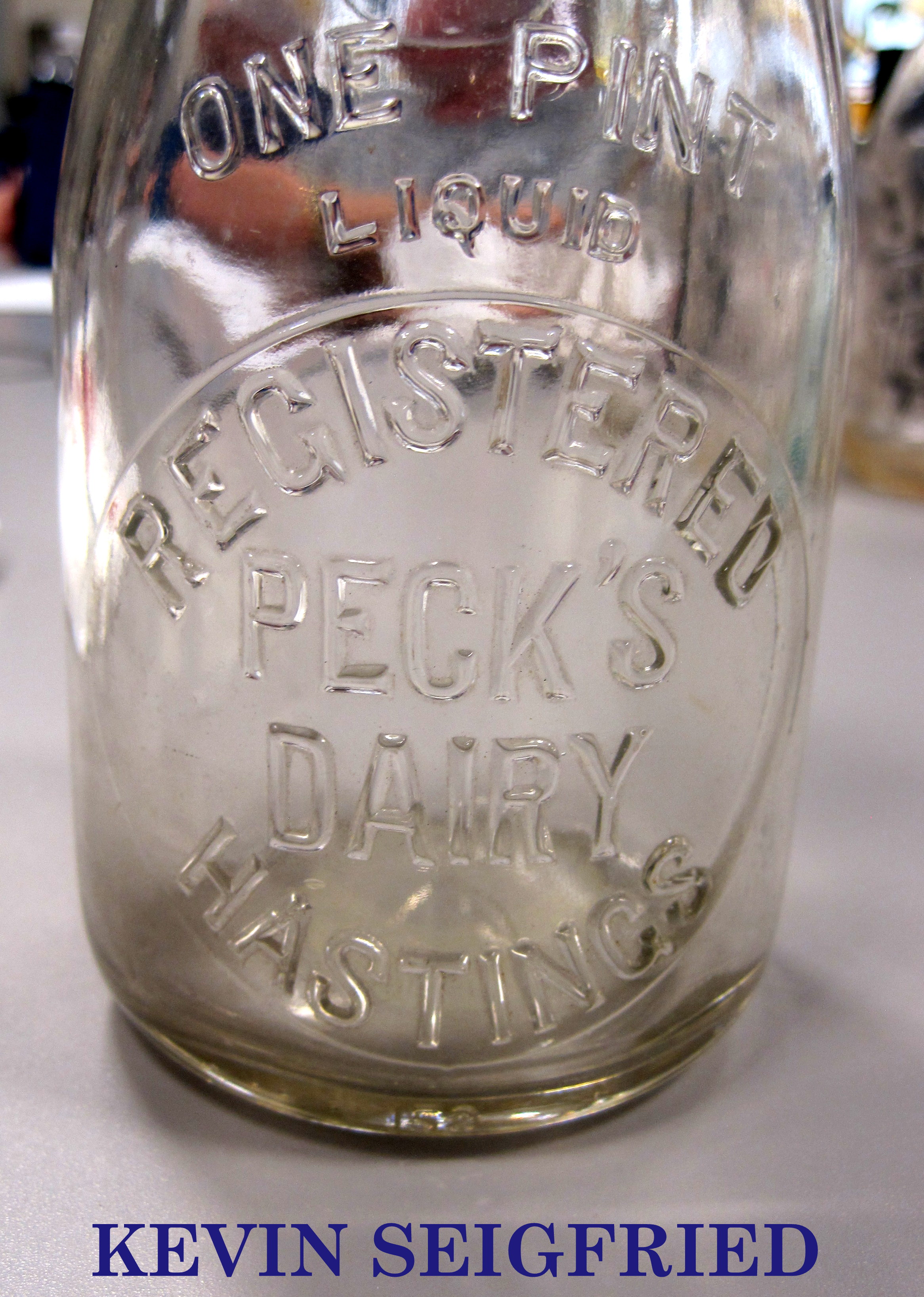 Next, Kevin displayed a 1- pint “Shaw
& Cox, Blue Ribbon
Next, Kevin displayed a 1- pint “Shaw
& Cox, Blue Ribbon 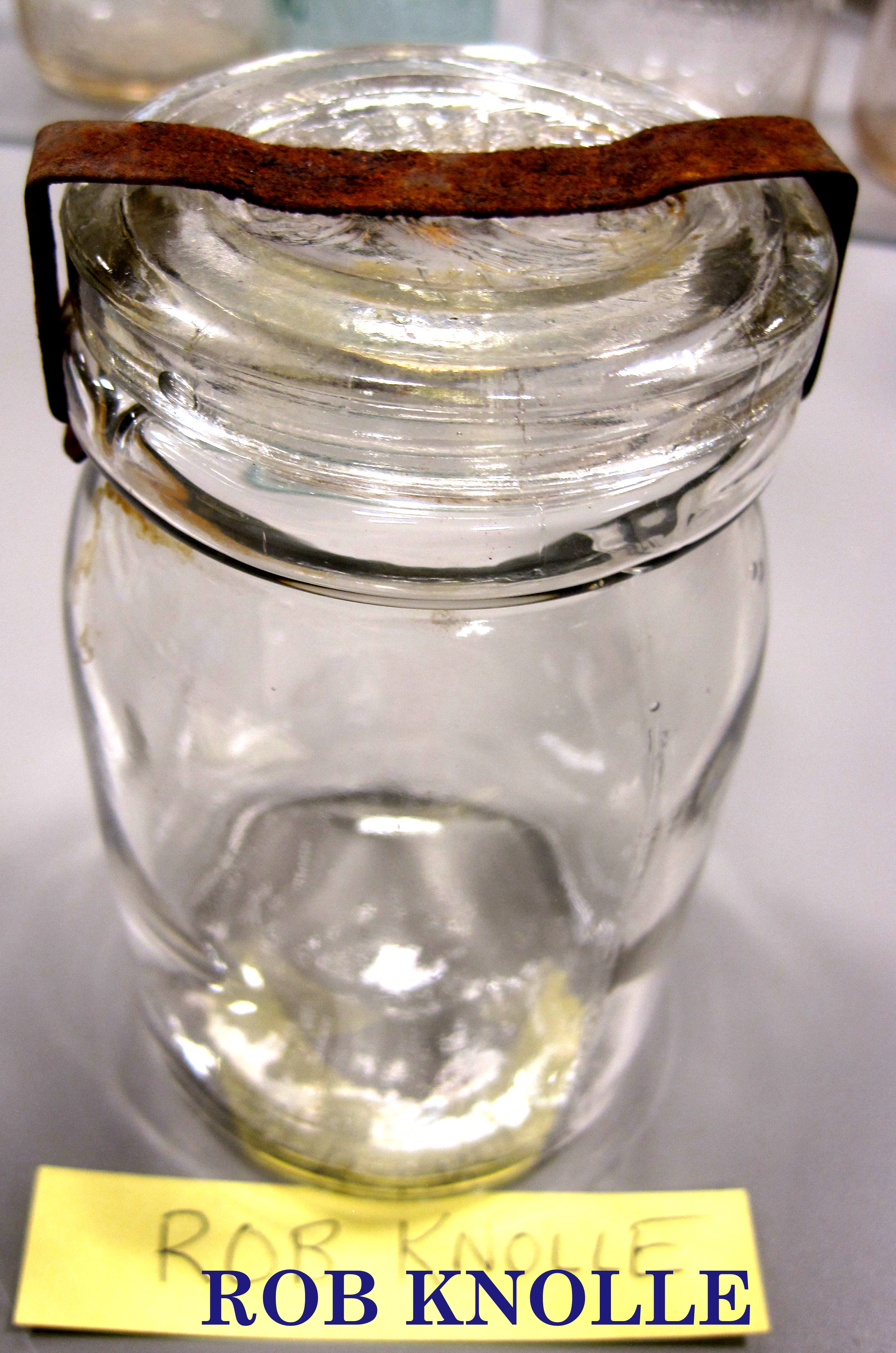 Dairy,” Middleville, MI, also with a
embossed slug-plate. Dairy,” Middleville, MI, also with a
embossed slug-plate.
Another beauty that Kevin showed up with was a
1-pint, embossed slug-plate “Peck’s Dairy” from
Hastings, MI.
Next, we went from cow’s milk right into mother’s
milk! Kevin brought in a nice assortment of early
glass baby bottles. One example was a rounded bottom
half-pint tear-drop shaped bottle with a raised
neck. This little nurser is embossed with a star
circled by the name “Babe’s Companion”
Kevin had some interesting ‘double ended’
nursers embossed “Eagle Feeder.” This style of
1800's nursers is sometimes referred to as 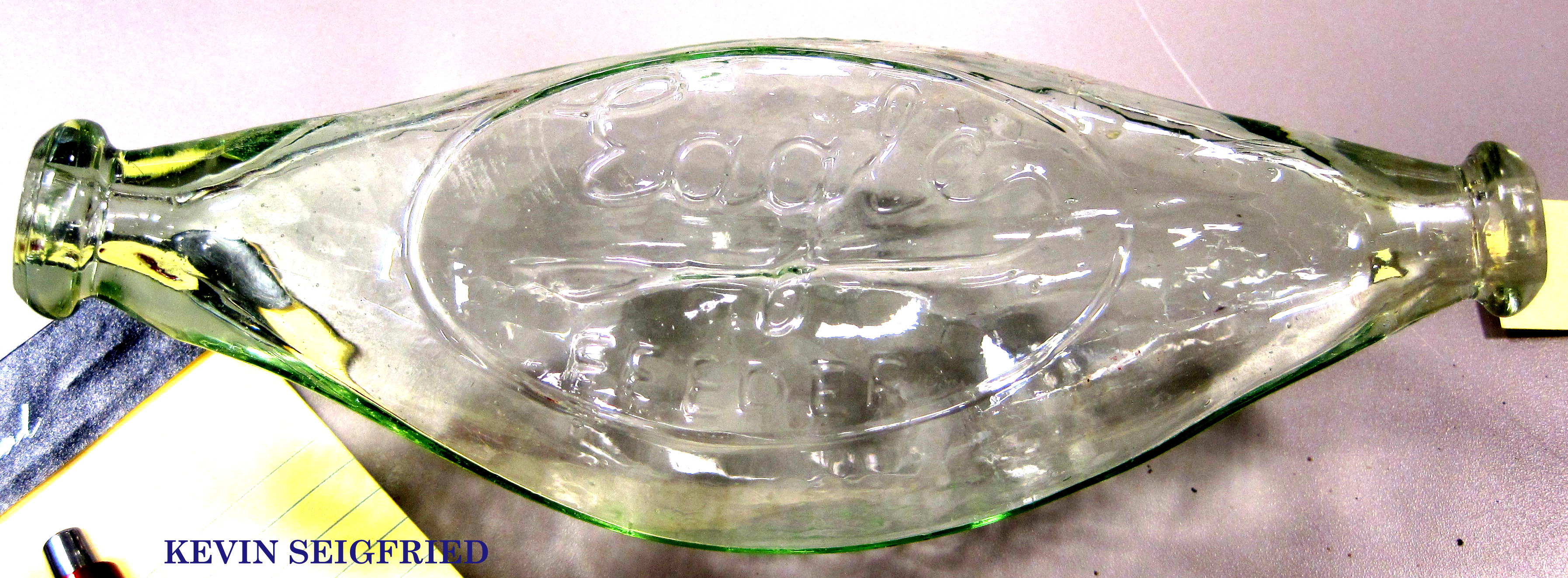 banana bottles. banana bottles.
When I first saw the double ended nursers I
had no clue!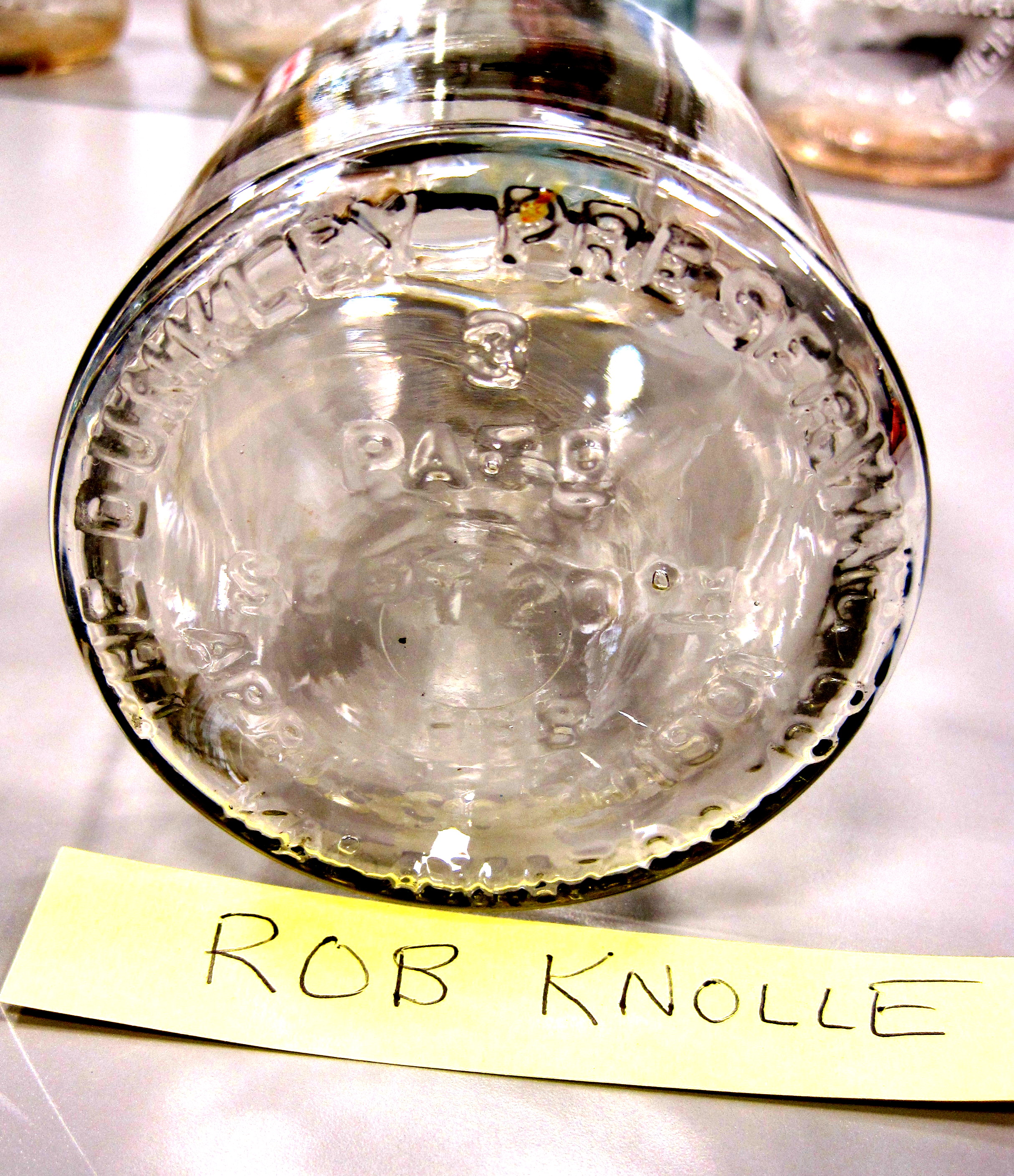
“Why would they accept a nipple at each end?”
I suggested it was for conjoined twins. I know that
is not funny. But what could it be?
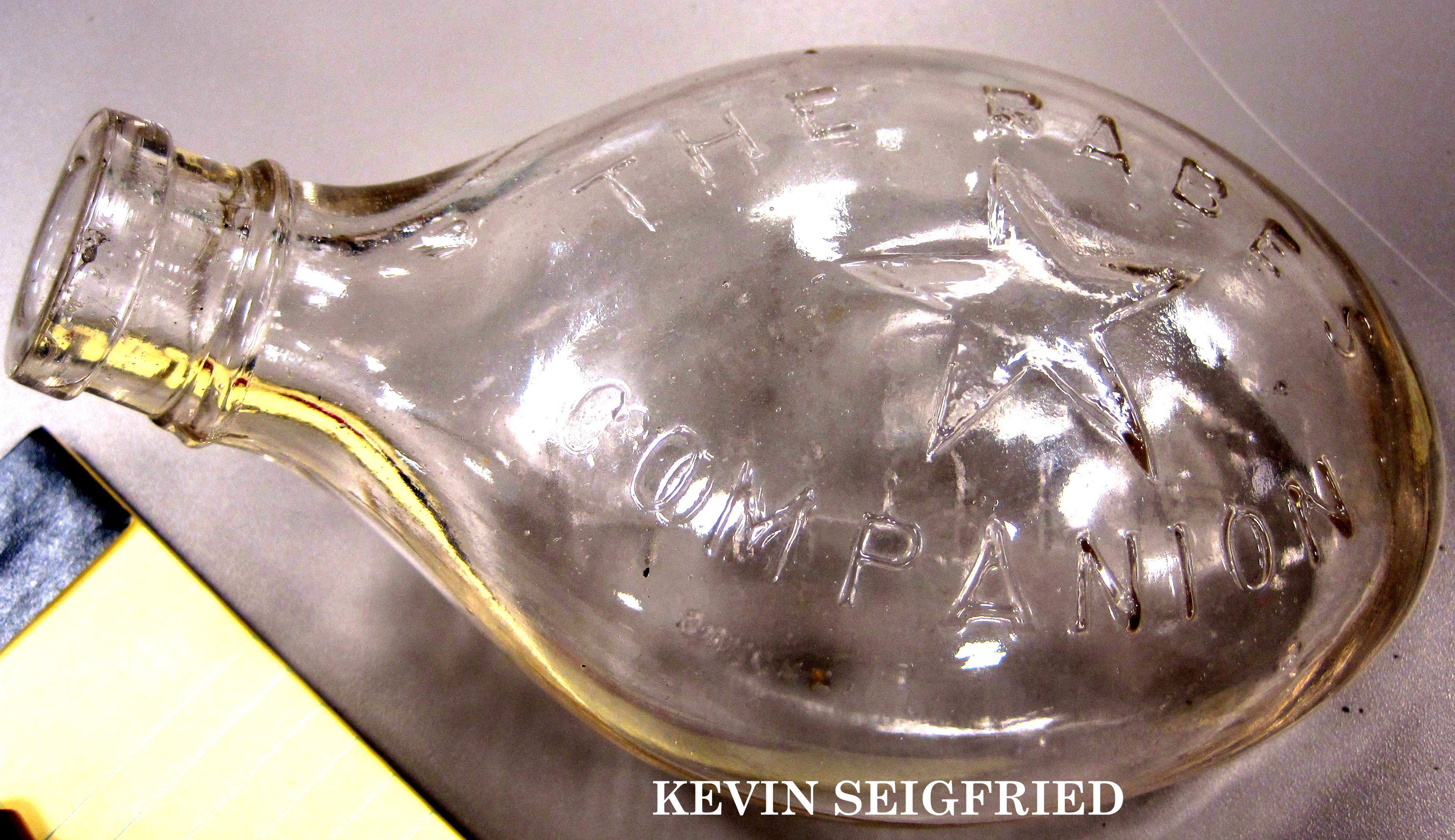 Early baby nursers have been found in
ancient Egyptian tombs which were very similar to
tiny clay cream pitchers like you may see in a
child’s tea set. Early baby nursers have been found in
ancient Egyptian tombs which were very similar to
tiny clay cream pitchers like you may see in a
child’s tea set.
They were made from kiln baked clay and glazed for
easy cleaning, no problems there. Of course the one
doing the feeding was controlling the flow all
during the feeding.
When the baby bottles became dangerous was when
inventors saw $$ to be had, by building a better
mousetrap!
This glass baby’s bottle with the rubber hose and
nipple was eventually referred to as a “Murder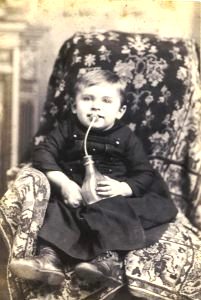 Bottle.” Bottle.”
These bottles, which resembled the shape of a
banjo, were most popular during the Victorian
age. Mothers at the time thought that having a
bottle which could help their young child virtually
feed him or herself, was something to be proud of.
These “killer” bottles were made under the brand
names ‘Mummies Darling’, ‘The Princess’, ‘Little
Cherub’ or ‘The Alexandria,’ giving the bottles an
air of quality & safety!
Not only were they were very
difficult to clean, but a very popular figure of the
time, a Victorian “lifestyle guru” called Mrs.
Beeton (Mrs. Beeton’s Household Management) was
writing in her nationally published advice column
that it was not necessary to wash the nipple for 2
to 3 weeks!
The bottle itself could be made
from glass or even earthenware. Corked with a rubber
stopper, threaded with a rubber feeding tube,
running from the bottle to a nipple, it was a
perfect device to breed bacteria. The stoneware
bottles were nearly impossible to clean and totally
impossible to inspect! They were bacterial breeding
farms!
Today we have unthinkable
abortion. For the most part, I believe our ancestors
cherished their offspring. During the 19th century,
even doing your best to love and care for the little
ones was hazardous! If Mrs Winslow didn’t kill them,
their baby bottle might!
The double ended banana bottles
were the solution to baby bottle problems!
Even though they were double ended, and able
to accept two rubber nipples, one end was used to
vent the bottle.
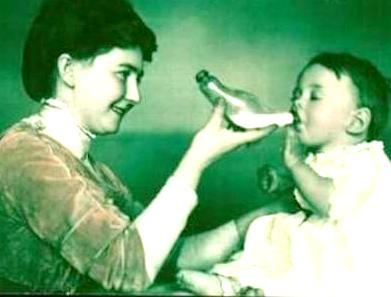 The beauty of the banana
bottle was that it was open ended, so a good, firm
bristled bottle brush could be passed right on
through. Also, being open ended it could be rinsed
completely, and being transparent, you could see and
control everything for a good effective cleaning.
With the bottle cleaned, then rinsed in boiling
water, it was truly sanitized. The beauty of the banana
bottle was that it was open ended, so a good, firm
bristled bottle brush could be passed right on
through. Also, being open ended it could be rinsed
completely, and being transparent, you could see and
control everything for a good effective cleaning.
With the bottle cleaned, then rinsed in boiling
water, it was truly sanitized.
While banana bottles are rarely
seen today, in the late 1800's and early 1900's they
were very popular in the U.S. and Europe.
When I was growing up, my
friend’s family lived on Mitchell Street in Otsego.
Their home was on the very end of the street. When
you reached the end of the road, there was a foot
path leading down to the river. On both sides of
that path there was a swampy area that someone had
been using for a dump.
We liked to play in that area.
His folks had a little blue berry patch, and just
past that, my friend had a crude little duck blind
on the Kalamazoo River bank.
One day when the water table was
low, we started exploring areas that had dried out
more than usual. In a large group of thickets, we
found 2 partially buried 1920's automobiles.
We decided that we would
dig them out and build a couple of hot rods! Armed
with a shovels, we went to work. The ground
was soft and we had ample strength and great
motivation. Under normal conditions, we were sure it
would have all worked out. The surprising problem
was getting the shovel in the ground . . . it was
not good!
The digging conditions were
horrible! It was so bad because it was like using a
shovel to dig a hole in a sidewalk! We were running
into thick buried glass, lots of it! The glass was
huge piles of baby bottles!
Someone, perhaps a company,
store or a hospital, dumped a huge load of the
old style baby bottles!
I have wondered about this for
many years. (This all took place before I had any
clue about antique bottle collecting.)
As I recall, most of the baby
bottles were the turtle style bottles. They may have
been dumped during the “Murder Bottle” public scare?
I am sure they are still
out in that swamp. Or maybe not. This was
decades before the recent river clean-up so today
they may all be gone.
I do know that they are planing
to continue the Kalamazoo River walk project through
that same area. Ironically, there
was some heated controversy regarding this property
in the newspaper very recently. After my friend’s
mother had passed away, the family put the property
on the market.
The City of Otsego had made an
offer, but before a counter offer could be
considered by the local bureaucracy, a third party
swooped-in and paid the asking price! And, as I
recall that third party was someone on the Otsego
City board! Needless to say, that didn’t go over
well! !
Moving on with our
treasure display.
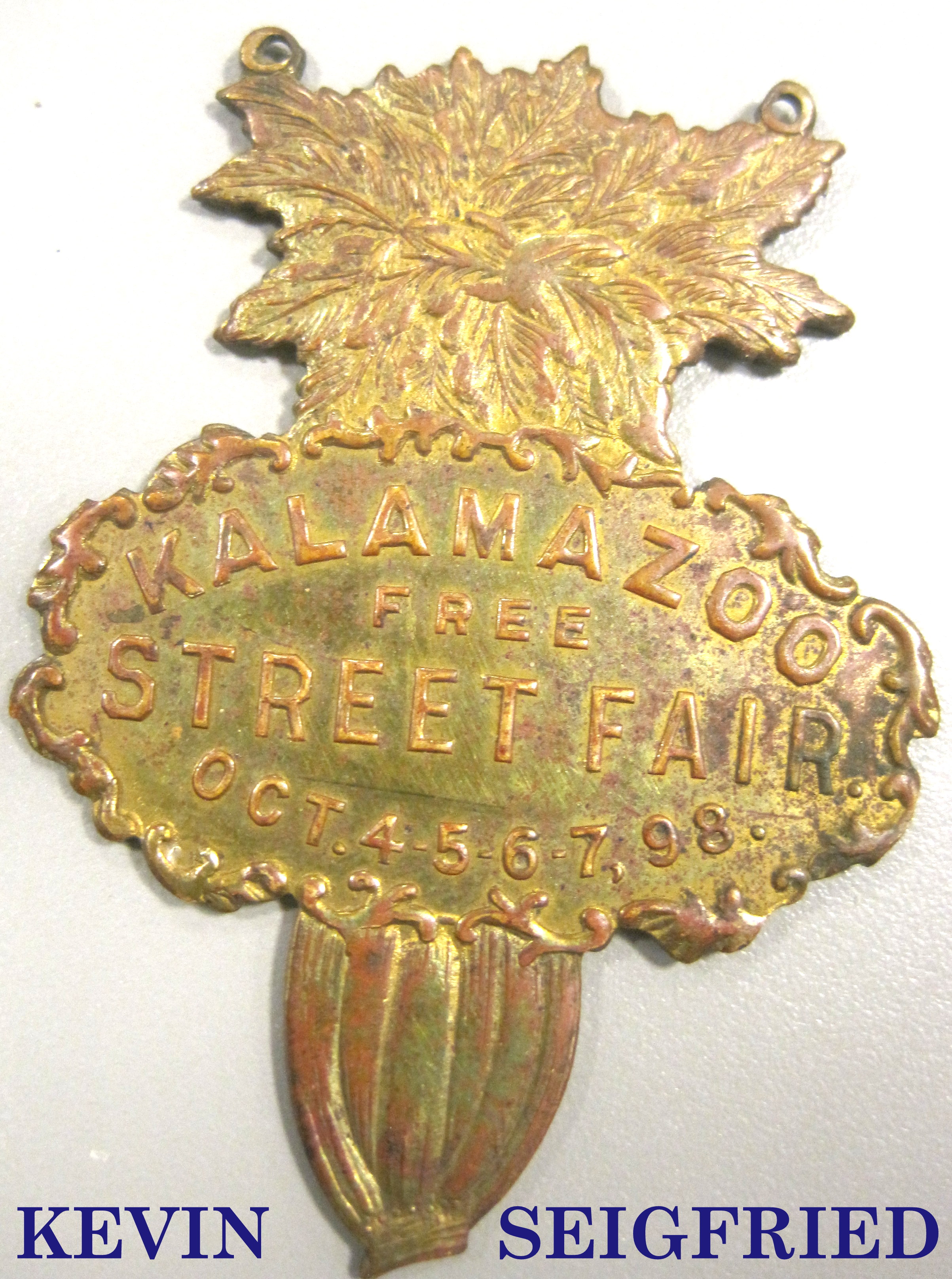 Kevin
really had us going with more treasure! Kevin
displayed a beautiful aqua MASON’S
PATENT NOV 30th 1858-type jar marked with a
“Maltese Cross” symbol. Kevin
really had us going with more treasure! Kevin
displayed a beautiful aqua MASON’S
PATENT NOV 30th 1858-type jar marked with a
“Maltese Cross” symbol.
The Maltese Cross indicates that
the jar was blown at the Hero Glass Works / Hero
Fruit Jar Company of Philadelphia, PA, either
above or below the word MASON’S. On many
examples, the letters “H”, “F”, “J” and
“Co” can be faintly seen within each “arm” of
the cross. On others, no letters are visible.
Looking at my photos, I could not see any letters.
I should note: Most of the web
sites I found while researching this bottle
posted large colorful warnings about a never ending
flow of fake- colored Mason Jars filling the
decorator market. They point out that this trend
started in the 1970's and many of these decorator
bottles have worked their way into estate sales,
antique malls, and auctions . . . buyer beware! Of
course, we know and Kevin knows that his jar is the
real deal.
Kevin found an attic-mint medal
from the 1898 Kalamazoo Free Street Fair! I have
seen a couple of these that were metal detecting
finds, but clearly this beauty was never corroding
in the dirt! As you can see, it was attached to a
pin or ribbon and is in the shape of a celery bunch!
Very cool!
Rob Knoll found a Kalamazoo Dunkley’s Preserve Co.
Canning jar with an original spring steel top band.
We learned at the Kalamazoo bottle show that this
one is a real keeper but the most valuable part
isn’t the glass, it is that original steel closure!
I didn’t have as much time to
spend researching this as I would have liked. We
already learned about the bottle from one of the
best - - my friend, Doug Leybourne!
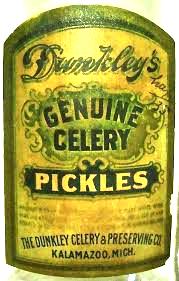 I wanted to learn about
what sort of “Preserves” was put up in the Dunkley
Preserve Co. jars. Most Kalamazoo collectors know
that Dunkley was a big name in the Kalamazoo Celery
industry. He was a grower, packer, shipper and
promoter for all things celery-related. However, all
around I wanted to learn about
what sort of “Preserves” was put up in the Dunkley
Preserve Co. jars. Most Kalamazoo collectors know
that Dunkley was a big name in the Kalamazoo Celery
industry. He was a grower, packer, shipper and
promoter for all things celery-related. However, all
around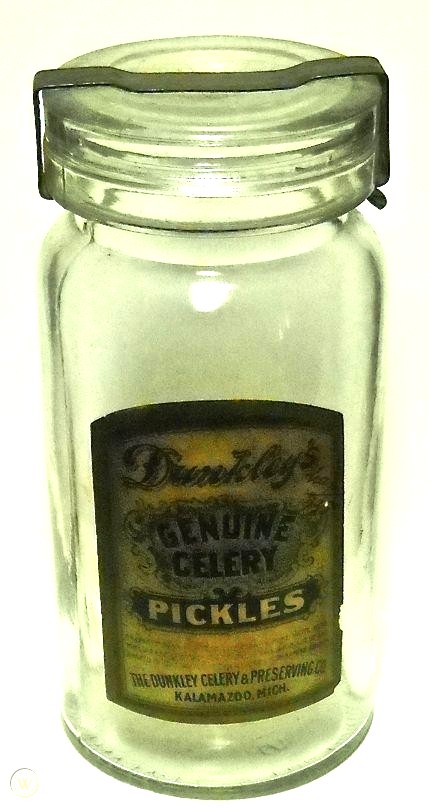 southwest Michigan near the Celery
City, this area was known nationally as the “Fruit
Belt.” southwest Michigan near the Celery
City, this area was known nationally as the “Fruit
Belt.”
As near as I was able to learn,
Rob’s preserve jar was a “PICKLE JAR” and not just
any pickle! It was for Dunkley’s Celery Pickles!
I found an ad for Dunkleys in an
1893 issue of the Anaconda Standard, a newspaper
that was considered by journalists as the icon
of Montana newspapers. Anaconda, Montana was a
copper mining region.
This 1893 ad promoted:
Did
You Ever Eat Creamed Celery On Toast?
**Dunkley Canned Celery**
**Dunkley Pickled Celery**
**Dunkley Celery Salads**
To any lady who buys or asks for our goods, and
sends 3 ~ 2¢ stamps for postage, a package of
our famous Celery Nervine- Pellets, and one of
our beautiful embossed receipt books.
For 19¢ additional we will send a
two pound can of our famous celery. |
When I worked for Charlie Andrews in his
cider mill, he always had a wad of Red Man chewing
tobacco in his cheek. Of course, being 13 and 14
year old kids, we didn’t have access to chewing
tobacco, but we thought it was cool nonetheless.
Part of our job was hauling out the huge racks of
burlap apple pulp and adding it to the pile behind
the barn. We would pack a plug of apple pulp in our
mouth pretending it was tobacco! We thought it was
pretty good!
We
would grab an occasional apple from the bin to munch
on and we would carefully inspect them for evidence
of worms; in most cases there were! We weren’t as
fussy with the pulp tobacco. Charlie used to say,
“Worms add character to good cider.”
I say all this after seeing the promise of “for 3~2¢
stamps to cover postage, free Dunkley’s Celery
Nervine Pellets!” You just have to know these
wonderful, proven, world-renowned Nervine Pellets
were pelletized left-over pulp, a byproduct from
squeezing out celery juice for Celery Tone!
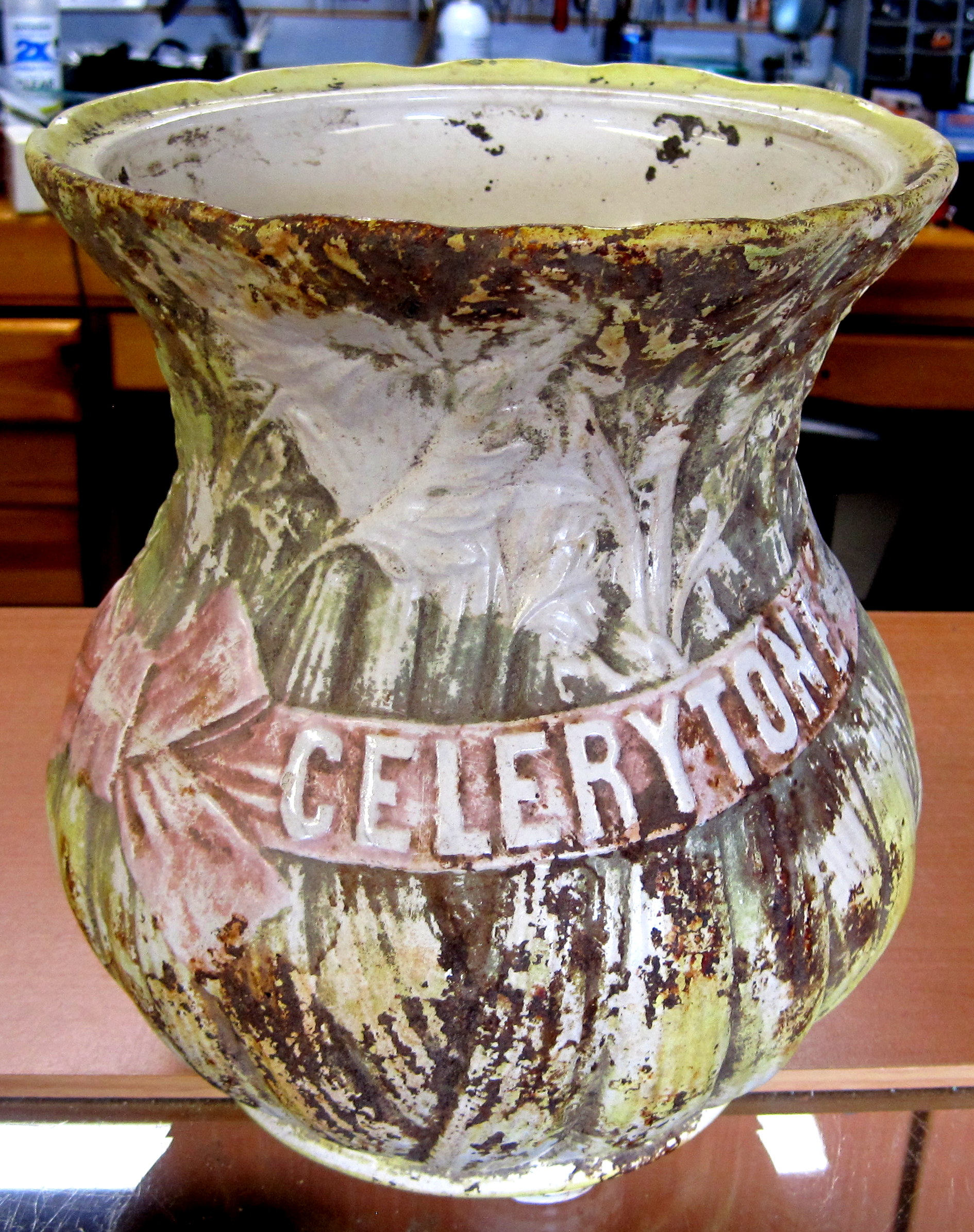 Speaking of
Celery Tone, Dunkley made a drink that was sold
through dispensers at drug-store soda fountains.
Celery Tone concentrate was kept in a dispenser on
the back-bar at the soda fountain. The "Kalamazoo
Celery Tone Kola" ("Made Where the Celery Grows"),
contained cocaine, caffeine, and celery juice, and
was marketed as a tonic to make you feel better and
relieve headache. Speaking of
Celery Tone, Dunkley made a drink that was sold
through dispensers at drug-store soda fountains.
Celery Tone concentrate was kept in a dispenser on
the back-bar at the soda fountain. The "Kalamazoo
Celery Tone Kola" ("Made Where the Celery Grows"),
contained cocaine, caffeine, and celery juice, and
was marketed as a tonic to make you feel better and
relieve headache.
Here is the kicker - - my buddy Sonjit dug part of a
Celery Tone Dispenser, and I managed to trade for
it!
I found a photo of an 1890's druggist soda bar with
a photo of a complete unit but information is very
hard to find! I think it is a true treasure!
We enjoyed some Binbo’s pizza at the last meeting.
Some of the guys brought some items to Bimbo’s but I
will have to cover those items in the next
newsletter.
Look to the far right corner of the bar!!!! Is
that cool?
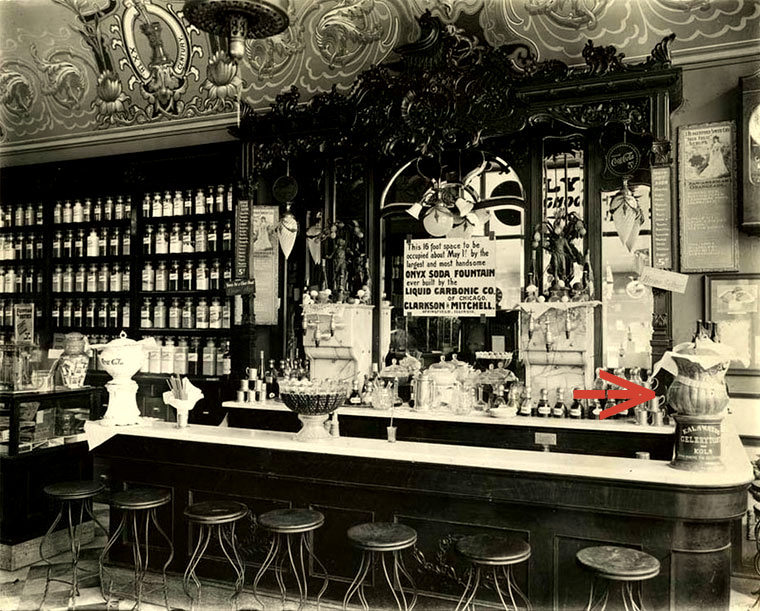
|

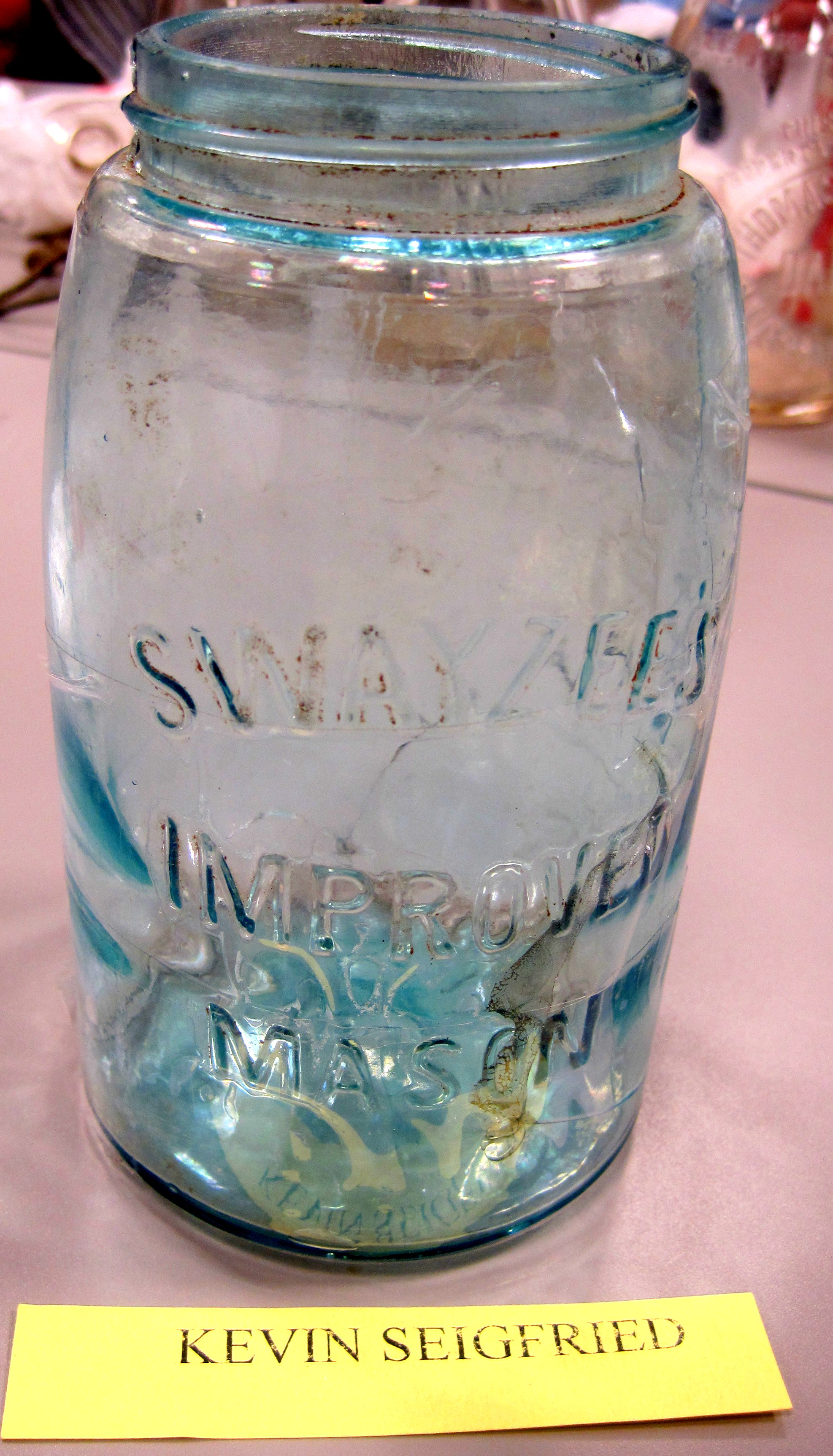 Kevin brought in some real beauties! One
was a one-quart, aqua “Swayzee’s Improved Mason” jar.
The Swayzee's Glass Company started producing fruit
jars in 1894. The company was located in
Swayzee, Indiana. In 1906, the Ball Brother’s
Glass MFG Co. bought the Swayzee Glass Co. for
$71,428. The company continued to make
Kevin brought in some real beauties! One
was a one-quart, aqua “Swayzee’s Improved Mason” jar.
The Swayzee's Glass Company started producing fruit
jars in 1894. The company was located in
Swayzee, Indiana. In 1906, the Ball Brother’s
Glass MFG Co. bought the Swayzee Glass Co. for
$71,428. The company continued to make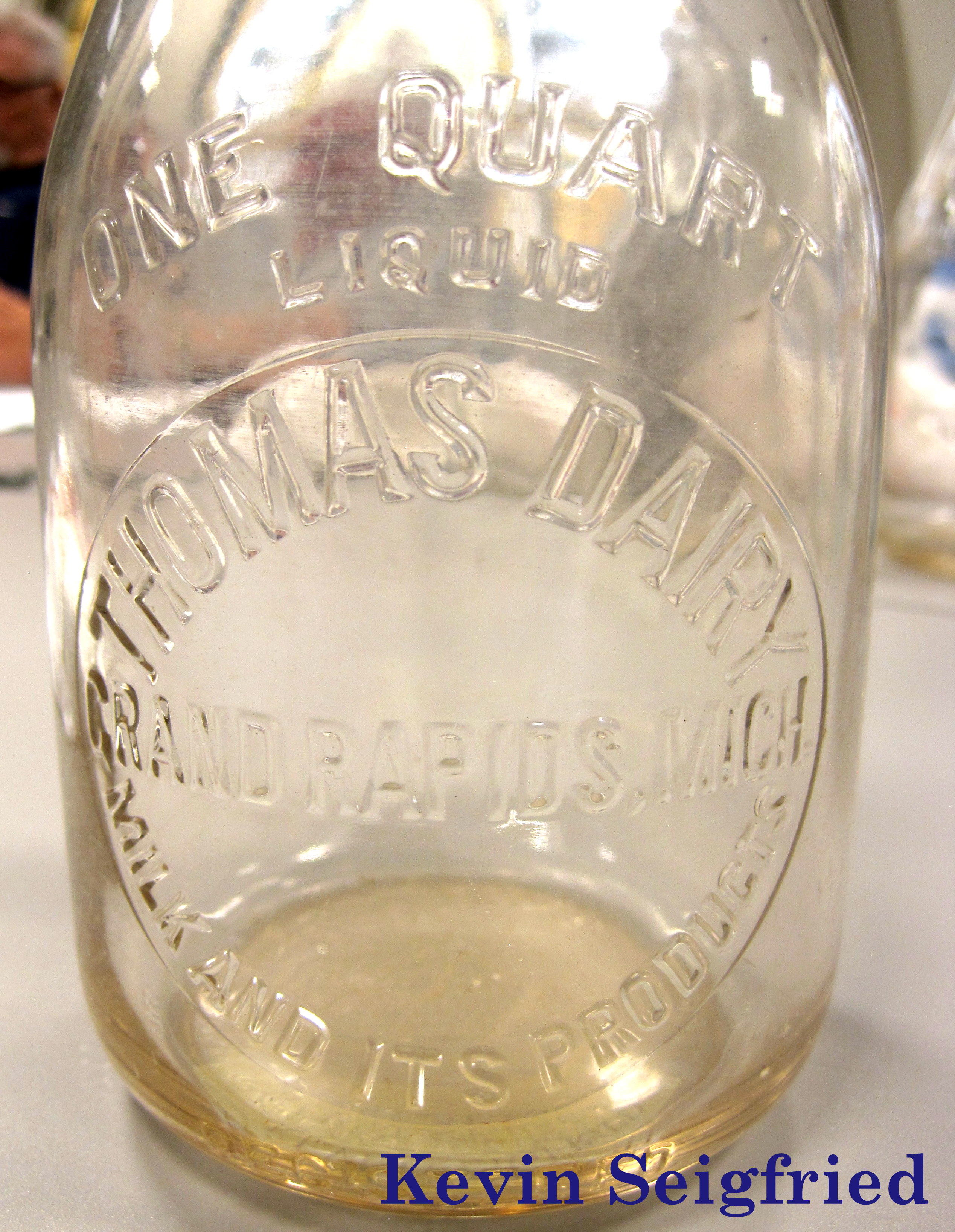 the Swayzee jar for one more year.
the Swayzee jar for one more year.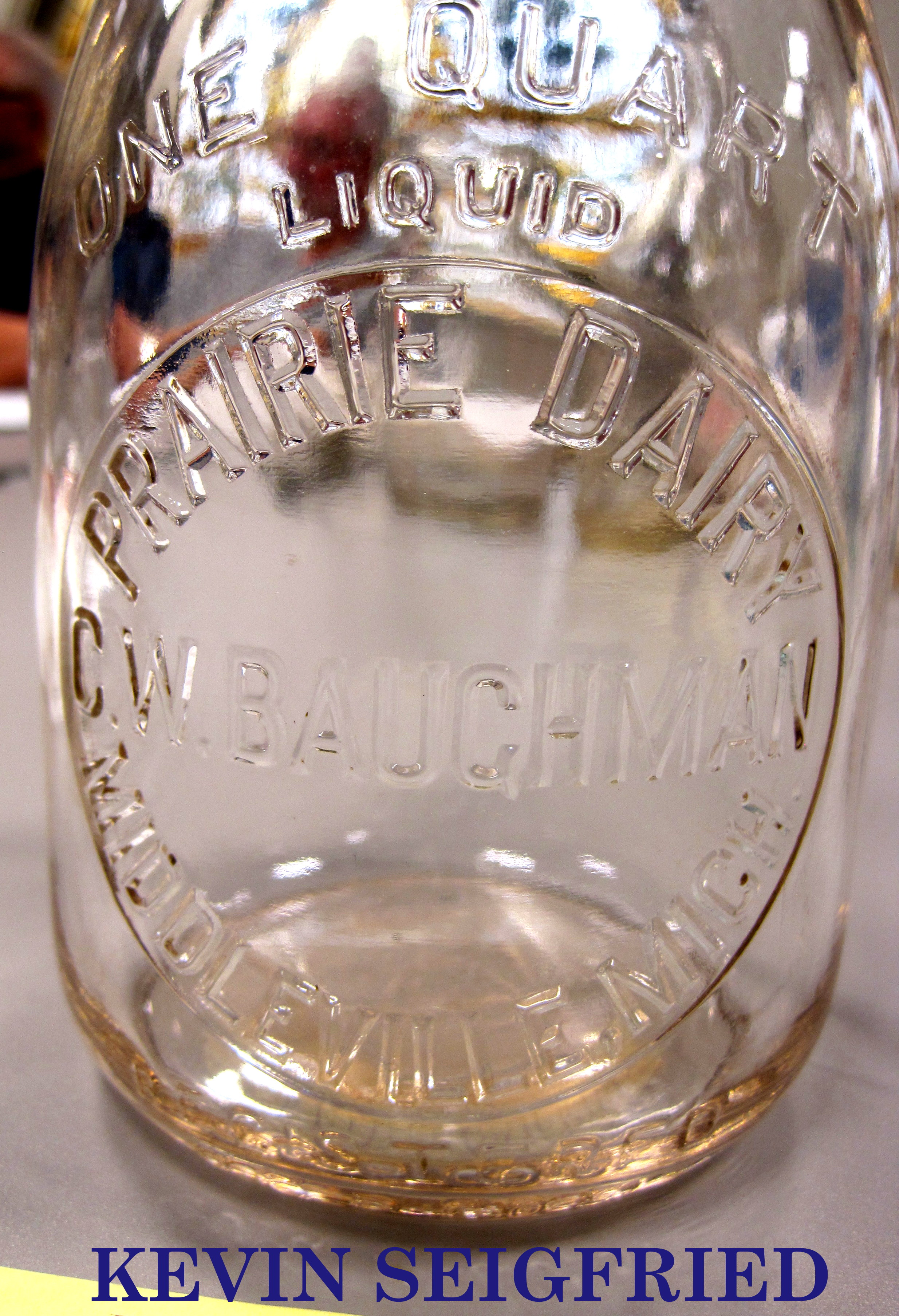 One of Kevin’s milk bottles
bought back some great memories for
One of Kevin’s milk bottles
bought back some great memories for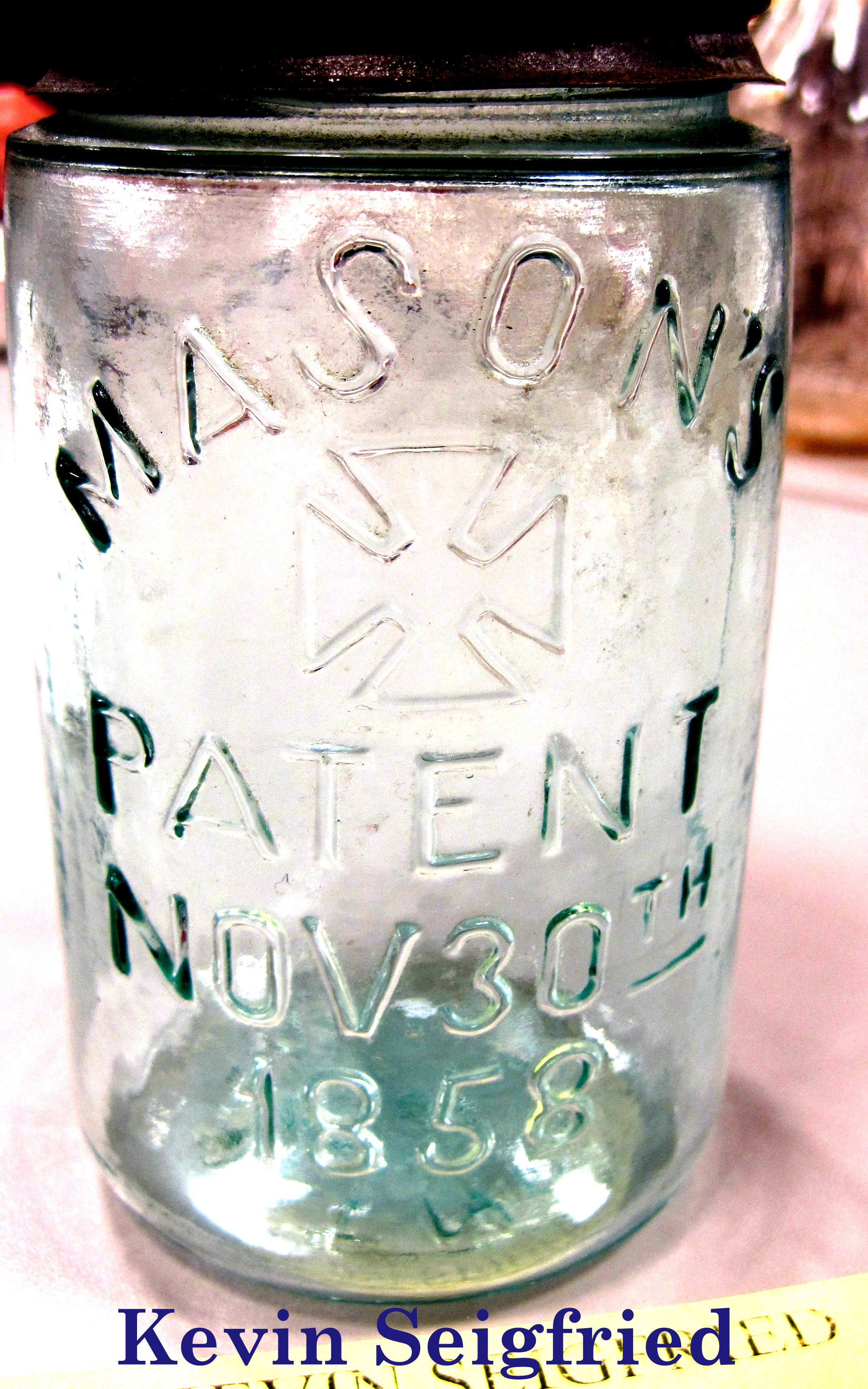 me. It is a very ornately embossed
“Schuiteboer Dairy” milk & cream” from Plainwell,
MI. bottle. On this bottle the name is embossed with a
beautiful flowing script with the word “DAIRY” within
a kite tail extending from the name. It reminds my of
the iconic Coca~ Cola script.
me. It is a very ornately embossed
“Schuiteboer Dairy” milk & cream” from Plainwell,
MI. bottle. On this bottle the name is embossed with a
beautiful flowing script with the word “DAIRY” within
a kite tail extending from the name. It reminds my of
the iconic Coca~ Cola script.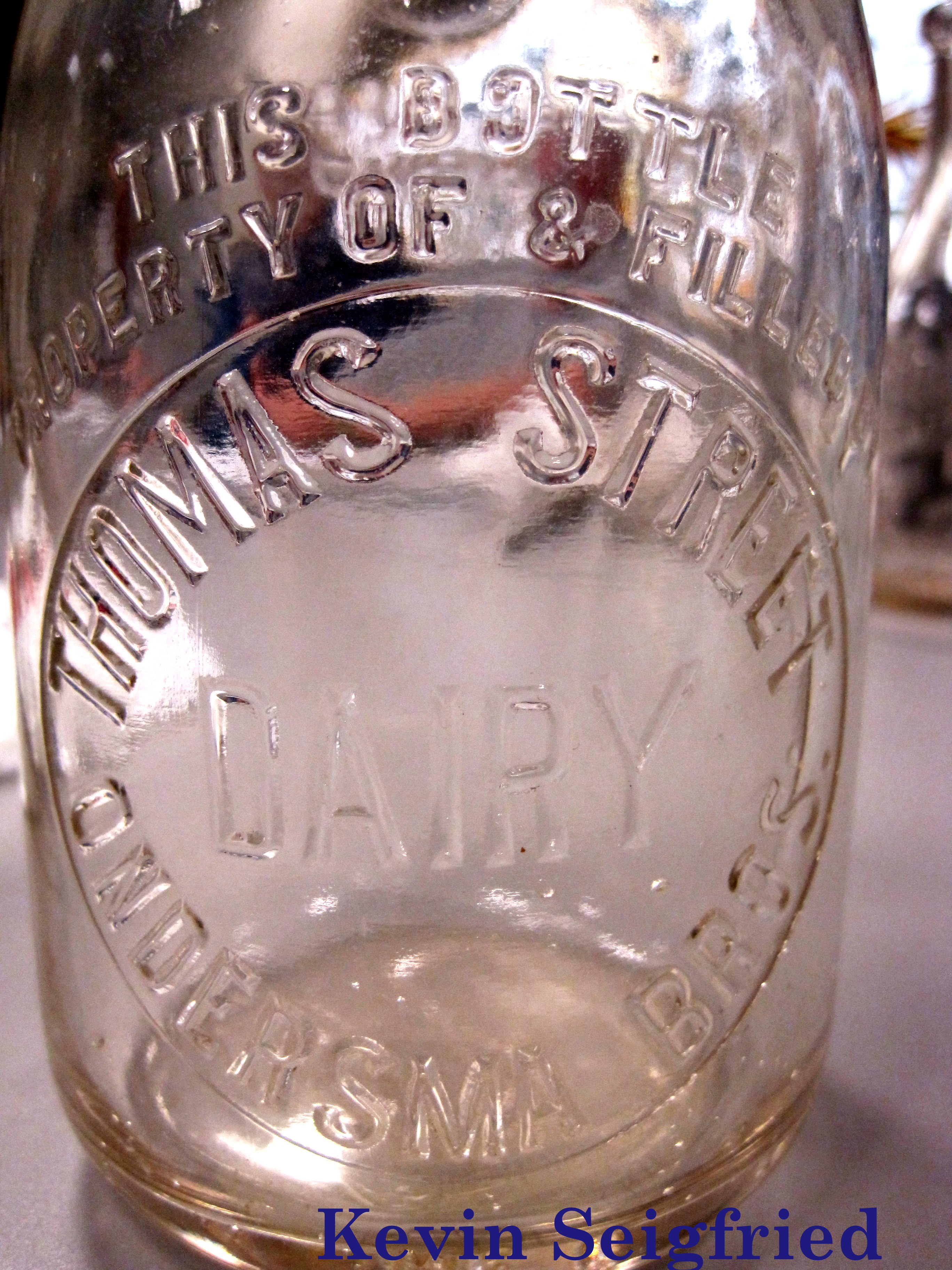 Plainwell school lunch supplied by
Schuiteboer Dairy. As I recall, it was 3¢ for white
and 5¢ for chocolate. It came in those little
half-pint school bottles capped with
Plainwell school lunch supplied by
Schuiteboer Dairy. As I recall, it was 3¢ for white
and 5¢ for chocolate. It came in those little
half-pint school bottles capped with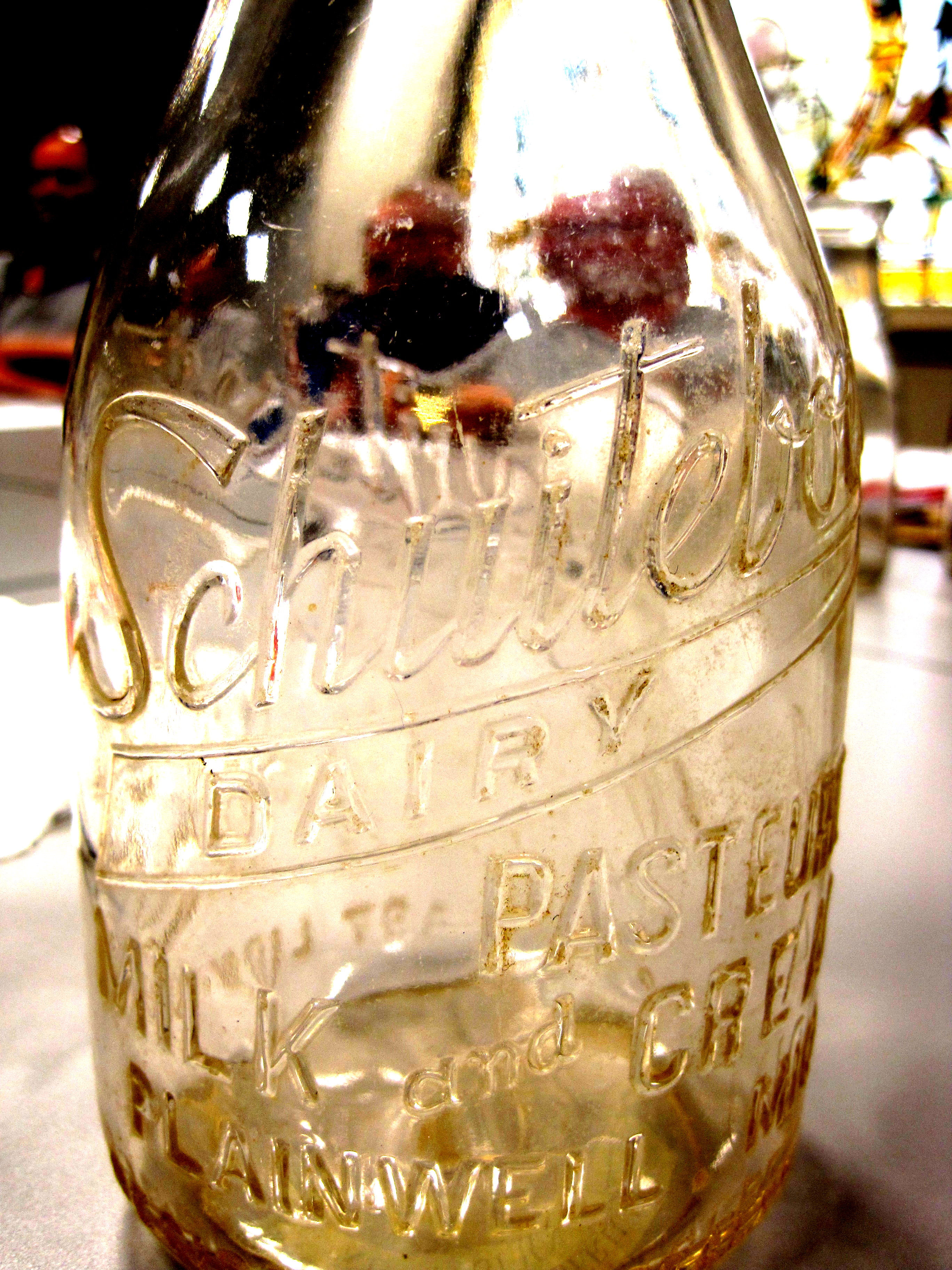 the cardboard inserts. Who would have
ever dreamed that I would be writing about Schuiteboer
school milk 63 years later!
the cardboard inserts. Who would have
ever dreamed that I would be writing about Schuiteboer
school milk 63 years later! Next, Kevin displayed a 1- pint “Shaw
& Cox, Blue Ribbon
Next, Kevin displayed a 1- pint “Shaw
& Cox, Blue Ribbon  Dairy,” Middleville, MI, also with a
embossed slug-plate.
Dairy,” Middleville, MI, also with a
embossed slug-plate.  banana bottles.
banana bottles.
 Early baby nursers have been found in
ancient Egyptian tombs which were very similar to
tiny clay cream pitchers like you may see in a
child’s tea set.
Early baby nursers have been found in
ancient Egyptian tombs which were very similar to
tiny clay cream pitchers like you may see in a
child’s tea set. Bottle.”
Bottle.” The beauty of the banana
bottle was that it was open ended, so a good, firm
bristled bottle brush could be passed right on
through. Also, being open ended it could be rinsed
completely, and being transparent, you could see and
control everything for a good effective cleaning.
With the bottle cleaned, then rinsed in boiling
water, it was truly sanitized.
The beauty of the banana
bottle was that it was open ended, so a good, firm
bristled bottle brush could be passed right on
through. Also, being open ended it could be rinsed
completely, and being transparent, you could see and
control everything for a good effective cleaning.
With the bottle cleaned, then rinsed in boiling
water, it was truly sanitized.  Kevin
really had us going with more treasure! Kevin
displayed a beautiful aqua MASON’S
PATENT NOV 30th 1858-type jar marked with a
“Maltese Cross” symbol.
Kevin
really had us going with more treasure! Kevin
displayed a beautiful aqua MASON’S
PATENT NOV 30th 1858-type jar marked with a
“Maltese Cross” symbol.  I wanted to learn about
what sort of “Preserves” was put up in the Dunkley
Preserve Co. jars. Most Kalamazoo collectors know
that Dunkley was a big name in the Kalamazoo Celery
industry. He was a grower, packer, shipper and
promoter for all things celery-related. However, all
around
I wanted to learn about
what sort of “Preserves” was put up in the Dunkley
Preserve Co. jars. Most Kalamazoo collectors know
that Dunkley was a big name in the Kalamazoo Celery
industry. He was a grower, packer, shipper and
promoter for all things celery-related. However, all
around southwest Michigan near the Celery
City, this area was known nationally as the “Fruit
Belt.”
southwest Michigan near the Celery
City, this area was known nationally as the “Fruit
Belt.” Speaking of
Celery Tone, Dunkley made a drink that was sold
through dispensers at drug-store soda fountains.
Celery Tone concentrate was kept in a dispenser on
the back-bar at the soda fountain. The "Kalamazoo
Celery Tone Kola" ("Made Where the Celery Grows"),
contained cocaine, caffeine, and celery juice, and
was marketed as a tonic to make you feel better and
relieve headache.
Speaking of
Celery Tone, Dunkley made a drink that was sold
through dispensers at drug-store soda fountains.
Celery Tone concentrate was kept in a dispenser on
the back-bar at the soda fountain. The "Kalamazoo
Celery Tone Kola" ("Made Where the Celery Grows"),
contained cocaine, caffeine, and celery juice, and
was marketed as a tonic to make you feel better and
relieve headache. 
